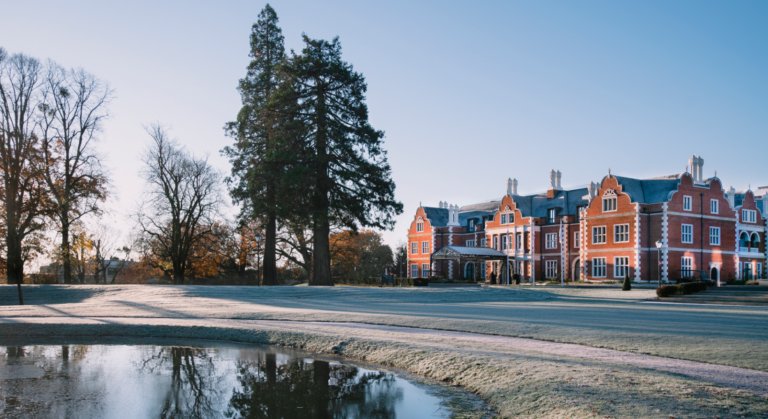By David G. Barry
In September, the Leona M. and Harry B. Helmsley
Charitable Trust announced that Chief Investment Officer Rosalind M.
Hewsenian would retire at the end of 2023 and that Joshua Fenton,
director of investments, would replace her. Hewsenian joined the philanthropic
organization in 2010, overseeing the implementation of its investment program –
an effort that has led trustees to describe her as a “visionary leader.” During
her 12 years at the helm, the Helmsley Trust’s assets have grown to $8.3
billion. The trust, which was formed in 2008 following the death of Leona
Helmsley, has committed more than $3.5 billion to a range of charitable
purposes.
Hewsenian recently sat down with Markets Group to discuss
her work at the trust, the outlook for investing, her time as a special ed
teacher and as a consultant to the California Public Employees’ Retirement
System (CalPERS), and what’s ahead for her in retirement. (Spoiler Alert: Dogs
and a certain popular game.)
Markets Group: Roz, how did the decision to retire
come about and why was it decided to announce it so far in advance of your
actual retirement in December 2023?
Roz Hewsenian: The organization was going through
planning and considering its staffing needs. Its office needs. All the things
that an organization should be looking at. Needless to say, one of the things
that came up in the discussion was, ‘you don’t think she could retire in the
middle of all this?’ And so, I was asked during one of my updates to the
trustees if I had plans to retire, and that was about five months ago. And I
said, ‘yes’ and gave them the date. They were surprised I had a date. The fact
of the matter is that I had set the date in my 20s. As a result, we all agreed
that we have to get on with it. I was going to go at the end of 2023. And so,
let’s talk about succession. Let’s talk about all the things you talk about. We
put everything in place and then it started to leak. So, Helmsley decided to
take control of the narrative.
MG: How did you decide your retirement date in your
twenties?
RH: I had started my first job out of business
school. Going through new hire orientation, the benefits manager came into the
room to discuss not only our health benefits, but retirement benefits, too. She
made a strong point about beginning to plan for retirement now, and for most of
us in the room we were in our twenties. I took her seriously and started my
retirement financial planning then, setting money aside from each paycheck in
addition to the benefits my new employer promised. To plan adequately, that
benefits manager said, you should pick a retirement age, so I did. It never
changed.
MG: And so, you’ll be around over the next 14 months.
What do you want to accomplish during that period?
RH: Well, we are beginning our strategic planning
process for what we think is going to be a new economic and market regime. The
last 30 years have been dominated by declining and then very low interest
rates, very low inflation, very high growth. And we don’t expect that to
continue even if we get through this market debacle. It’s probably going to be
slower growth going forward and probably inflation will settle out lower than
where it’s been this year, but higher than the last 30 years, so about 4% or 5%
instead of 2% or even 1% at times. That really augers for looking at not only
how are we organized as a staff but how do we want to position our portfolio.
Where the changes are going to be made on the margin and that’s probably going
to take up a good portion of my time before we actually launch the formal
strategic planning process. Step one is assessing what the risks are. Step two
is to develop assumptions about the implications of those risks. Step three is
to look at what the investment alternatives are and then step four is to
actually present the assumptions to our investment committee. Step five is
launching the strategic planning process. So, I’ll probably leave in the middle
of all that.
MG: But when you leave your CIO role, you’ll join the
trust’s investment committee, which means…
RH: I’ll be in a position of having to approve the
work that I submitted. That’s going to be really funny. I can’t wait for our
first in-person meeting where I have to actually sit on the other side of the
table. But it’s going to be a busy year. I also will probably spend a lot of
time reaching out to the managers and the contractors that I worked with to
thank them for everything they’ve done for us at Helmsley because it’s been a
great ride for the 13 years I’ve been here. They’ve contributed mightily to where
we are today, which was when I first got here. You know, people were making
jokes about the dog, Mrs. Helmsley’s dog [whom she left millions for the care
of]. Now no one talks about the dog. Everybody takes Helmsley deadly seriously
on both the investment side and the program side, and I’m immensely proud of
that. We all stood shoulder to shoulder and worked very hard to accomplish
that.
MG: What led you to join the trust?
RW: It was a blank page. It was a new foundation.
Mrs. Helmsley had started the foundation back in the ’90s, but she used it as a
pass-through vehicle, more so than the way it operates today. She and her
husband were very generous. All you have to do is go around the greater New
York area and you see their names on hospitals all over the place. She would
make a major grant and would transfer assets into the trust from her personal
accounts. Then the money would be dispersed. Once she died, she left all of her
money to the trust. We’ve been in our current form only since 2008 and there
was no investment staff. Everything was starting up. What could be more
exciting than that?
MG: I assume you never met Mrs. Helmsley – correct?
RW: No, she died in 2007 before I joined Helmsley.
MG: As you look back at your time at Helmsley, is
building the program what you are most proud of?
RH: It’s not only building the program, but we did it
differently from everybody else, and this is the thing I’m most proud of, to be
honest. I got here right after the financial crisis. The first thing I did was
reach out to my foundation peers and even though [the late Yale CIO] David
Swenson had written his book about investing, it really pertained to university
and college endowments. And while people lump endowments and foundations into
the same bucket, they couldn’t be more different. The IRS grants university and
college endowments far more latitude than it does foundations. We are forced to
spend 5% of our assets every year, period. End of subject, no matter what. Yale
didn’t have to disperse a dime of any of the funds from its endowment if it
didn’t want to. The IRS did not force it to do that. That has a significant
implication for how you manage the assets and [Swenson] only addressed
foundations in his book in literally a paragraph or two – citing the differences
between foundations and endowments. That was it. After listening to all of my
peers tell me one after the other that the biggest obstacle they faced during
the financial crisis was liquidity risk, I decided, instead of managing to
volatility like everybody else does, we’re going to manage to liquidity.
MG: And what did that mean?
RH: As long as we have sufficient liquidity to
operate the trust, no matter what, that actually allows you to take on greater
volatility if you don’t have to transact. So instead of a traditional asset
allocation we allocate according to liquidity tiers, and they are defined
simply by how quickly we can get our hands on the money under the worst set of
circumstances where liquidity is impeded, either because the underlying markets
become illiquid or are locked up or there are legal constraints on an investor’s
ability to withdraw investments from hedge funds, that sort of thing. And so,
under the worst of circumstances, we told our trustees we will always make sure
that we will have two years of operating funds available. That’s because the
length of the average bear market since the post-World War II era has been
about two years. We actually have been able to take greater exposure to
alternative investments as a result. We’re more bar belled in that structure.
MG: How soon into your tenure did you feel comfortable
investing in alternatives?
RH: There were some physical assets transferred from
Mrs. Helmsley’s estate into the trust, defined as big buildings – like the Park
Lane Hotel. And there was a lot of cash that came in as well. As the trust was
liquidated, we would get these dollops of cash that would just show up. The
challenge was to make sure that we had a place to put money when we knew that a
property was up for sale and close to closing. We started our private capital
program early on, but we had to do it slowly because you can’t build it
overnight. We wanted to manage the ‘J curve’ because our trustees were very
concerned about this area of investing. They had never had exposure to it
before. Their experience with illiquid investments was real estate. They didn’t
know anything about venture capital or LBOs, or the myriad other things that
you can invest in privately.
MG: So, what was your approach?
RH: We started the program investing in secondaries,
which you bought at discount. Then you write it up to the net asset value and
that helped us manage our J curve. In the aggregate, we never posted a negative
rate of return in our private capital program as we got it going. That gave the
trustees confidence that we could manage the situation. They let us invest in
alternatives pretty early on and slowly but surely, we built it to where it is
today.
MG: Given that you started during the Great Financial
Crisis, it must have been a really good time to start a program?
RH: Oh, it was. It happened right after everybody was
hurting and we were running around Wall Street with a wheelbarrow full of cash.
We were able to take advantage of investments that were pretty cheap and that
really helped get us off the ground. But I think it’s also important to add that
our objective wasn’t to have the highest rates of return. It was to try to be
as consistent in our rates of return because one of the things that became
increasingly important was that, as the value of the investment program jumped
around, that actually caused the budget for the programs to jump around.
Remember, you’ve got to spend 5% of the assets. If the asset base varies, then
the 5% amount varies along with it. We have tried to provide as much stability
so that the programs could get off the ground with a degree of certainty of
funding because we were trying to establish our reputation in our program
areas.
MG: What does 2022 look like for the Helmsley Trust?
RH: This will be the first calendar year that we
probably will have a negative return since the first tranche of money had come
into the trust from the estate. We’re losing money right now like everyone else,
not because investments are blowing up. They are depreciating as the markets
are depreciating, although we have lost less than the markets so far this year.
MG: Roz, you started as a special education teacher
before going back to school and entering the financial world. What led to that
change?
RH: It was the early ’70s when I started in
education, and it was difficult to get a job because the Baby Boom generation
had moved through the school systems across the United States and the
generation behind was much smaller. The U.S. was actually going through a
period of closing schools, and they didn’t need as many teachers. So, I had to
scramble for something else to do. That left law, medicine, engineering, or
business. Well, there was a glut of lawyers, and I can’t stand the sight of
blood. Engineering was a possibility, but I thought instead, let me follow the
money. And that led me into business.
MG: You then spent a long period at Wilshire, an
institutional advisor. What were the key things you learned there and how did
it help you as a CIO?
RH: While I was at Wilshire, I was the lead
investment consultant at CalPERS and CalPERS was always in the media. There was
always a spotlight on it and everything we did was under that glare of light.
And I learned how to keep my cool, function under pressure and not let them see
me sweat. I understood and recognized that I had a tremendous opportunity
because CalPERS had a global reputation. So, my years at Wilshire gave me an
opportunity to step out into the global markets because of my work with CalPERS.
And I learned a tremendous amount – mostly how to work with boards and
communicate with each member. The CalPERS’ board had everyone from a school bus
mechanic from Indio, Calif., who was a good loyal union member and got elected
to the board and a Harvard-educated state treasurer with an MPA in governmental
finance from [Harvard’s] The Kennedy School; I had to be able to talk to both
of them at the same time in language they each would appreciate. That’s where
my special-ed training came in. What education training teaches you is how to
speak to where the individual is, and it doesn’t matter whether that individual
is 3 feet tall or 6 feet tall. The concept is the same. I had to make the
school bus mechanic from Indio feel important and help that person able to make
a multibillion-dollar decision as readily as the state treasurer with the MPA
from the Kennedy School. That helped me with my own trustees. They had no investment
experience. I had to make them comfortable.
MG: Did the experience keep you from wanting to be
the CIO of a public pension fund?
RH: I have a great deal of respect for governmental
pension funds. My mom was a governmental employee, and she drew her pension
benefits from the New York State Common Retirement System. She remained financially
solvent until the day she died at the age of 92 because of her pension
benefits. And so, I have a great deal of respect for governmental pension
funds. It was one of the reasons why I was drawn to them when I joined
Wilshire. But the glare of being in the public domain is hard. I gave it 21
years. I coached nine chief investment officers at CalPERS. I have a great deal
of respect for CalPERS and a great deal of respect for the opportunity I had,
what I learned and where it got me.
MG: Roz, you indicated that the investing environment
is set to change. How are you thinking about what strategies will make sense
going forward?
RH: I think we will probably be more U.S.-centric
than we’ve been. We have been more diversified internationally and we think that
the growth opportunities in the U.S. will be better than they will be in, let’s
say Europe or Latin America. We’re concerned about how China is conducting its
affairs. Right now, we do have investments in China, but we’ve learned that
when you shut down an entire country’s economy because of COVID, that has some
significant implications. So, we’re concerned about that. We won’t leave the
market entirely, but we want to make sure that our opportunities there are in
good hands and that not only can we make money but be able to exit investments.
We’re very careful about with whom we invest and how we invest. We’ll probably
be bringing some money home not only from China, but from Europe and Latin
America as well.
MG: What about the private markets?
RH: We think the underlying composition of our
private capital program will change at the margin. To give you an example, we
started what we call a “carbonomics” theme. It is a way of making money from
the decarbonization trend going on in the world right now. And our approach is
to invest in the technologies that will reduce carbon emissions – ones that
will make our use of fossil fuels more efficient – while at the same time,
looking at promising strategies for non-reliance on fossil fuels. But this is
not a social program. This is an economic program, and we think that it’s going
to be a big one as many companies have committed to their shareholders about
either zero carbon emissions or dramatically reduced carbon emissions. Even the
energy companies are talking about reduced carbon emissions as a goal. It’s
going to take technology to get these companies to their emission goals. That’s
an example of investments at the margin that we weren’t making under the
previous economic regime.
MG: Do you foresee any other changes?
RH: We’ll probably go back to debt investments. When
interest rates were as low as they were, we had moved out of private debt. So,
we’ll be probably looking at that to some extent and we’re always interested in
different novel investments. We understood and recognized that interest rates
couldn’t stay low forever and that as interest rates rise, traditional fixed
income depreciates. So, we made an investment in life settlements and that has
been a huge ballast in terms of a rate of return completely uncorrelated to the
financial markets. We did a lot of work on it and that’s an example of
something that we did that was just very different and we’ll be looking for
those kinds of investments as well.
MG: What about real estate – especially since that’s
where the Helmsleys made their money?
RH: We have invested in real estate, but not to the
extent that people probably perceive. I can’t tell you how many times we get
approached about a possible real estate deal that someone wants us to invest in
because we are Helmsley. But it’s very difficult for a foundation to invest
directly in a building and operate it. So, we’ve hired external money managers
to manage our real estate and have made an appropriate allocation for the risk
and return profile that real estate will provide. It doesn’t dominate the
private capital program simply because Helmsley was a real estate investment
company before the money passed to the trust.
MG: Aside from going on the investment committee,
what are your plans and hopes in retirement?
RH: I sit on a corporate board right now and I’m
truly enjoying that work and I’d love to continue on that board and join
another corporate board because I found that I really do enjoy board work. I’m
looking forward to serving on Helmsley’s investment committee. I’ve been
approached about joining another not-for-profit investment committee – and I’m looking at that. Outside of what I’ll
call professional endeavors, there are a couple of things that I’m thinking
about doing. One is I rescued a dog during the pandemic and learned a lot about
dog rescue. Unfortunately, my dog didn’t have the best rescue situation and I’m
sort of dealing with that now, but we’re getting her to where she needs to be.
I want to see dog rescue done right, and to do so I want to get more involved
in that in my retirement years. And then, like all good retirees, I think it’s
incumbent upon me to learn how to play pickleball.












